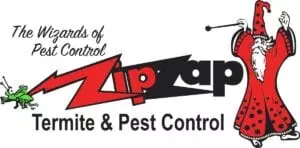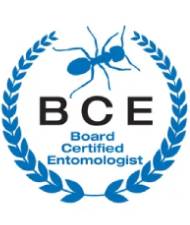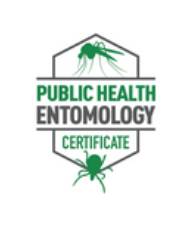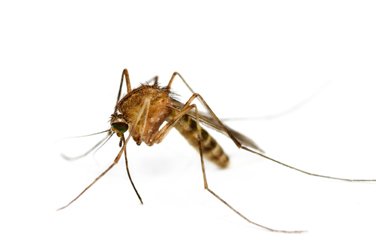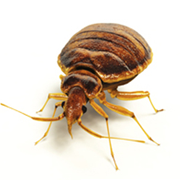Pests That May Cause Damage to Your Property
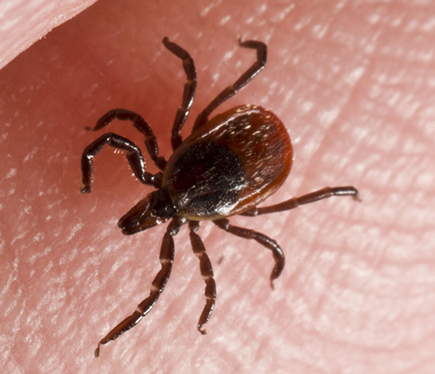
Ticks & Fleas
Fleas are an essential pest because they cause discomfort from biting, but also can transmit several diseases such as plague and murine typhus. The cat flea is found throughout the United States and is the most common flea encountered.
Ticks are ectoparasites that suck blood and cause significant skin lesions that can cause secondary infections of the tissue. They are capable of transmitting a wide variety of diseases such as Lyme disease and encephalitis.
Ants
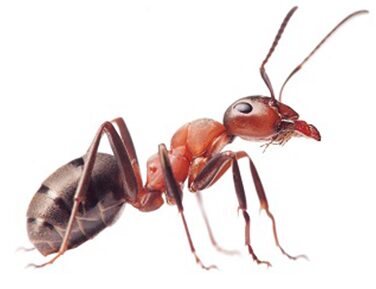
Ants in Kansas City: Carpenter Ant, Little black Ant, Odorous House Ant, Pavement Ant, Pharaoh Ant
Carpenter Ants in Kansas City:
Carpenter ants in Kansas City can create major problems in your home. They are attracted to wood and moisture in homes. Carpenter ants do not eat wood, they shred it, making it look like sawdust in your Kansas City home. Members of Genus Camponotus [Hymenoptera: Formicidae]: Carpenter ants are widespread in Kansas City. We are an exterminator in Kansas City that can take care of your pest control needs in Kansas City.
Little Black Ants in Kansas City:
Little Black ants in Kansas City are a nuisance. Monomorium minimum [Hymenoptera: Formicidae]: Little Black ants are omnivorous and common in urban habitats. Worker ants are monomorphic, ranging about 1.5 – 3.0 mm long. They have slender bodies and are dark brown or black. Ant colonies nest outdoors and form conical craters. We are an ant expert in Kansas City that can take care of all your pest control needs in Kansas City.
Odorous House Ants in Kansas City:
Odorous House Ants (OHA) in Kansas City are an ant that generates many calls to our office. This ant is mainly active from early Spring to late Fall. Tapinoma sessile [Hymenoptera: Formicidae]: Odorous House Ant is a species that is widespread in Kansas City as an urban pest. Worker ants are about 3.0 – 3.5 mm long and monomorphic. Odorous House Ants are brownish grey with velvet-like appearance. They typically nest outdoors in soil or under wood and stones but will nest in your kitchen walls as well. We are an exterminator expert on Odorous House Ants in Kansas City that can take care of your pest control needs in Kansas City.
Pavement Ants in Kansas City:
Pavement ants in Kansas City are a nuisance to the outdoors. We generally don't see many of these ants indoors, although they can become an ant problem in our Kansas City homes. Tetramorium caespitum [Hymenoptera: Formicidae]: Pavement ants are omnivorous and forage throughout the year. They seek sweets and grease indoors, plant materials outdoors, and feed on roots and seeds. We are an exterminator in Kansas City that can take care of Pavement ants in and around your Kansas City home.
Pharaoh Ants in Kansas City:
It is best not to spray a colony of Pharaoh ants when you find them around or in your Kansas City home. This could cause the colony to bud and become a lot bigger problem. Monomorium pharaonis [Hymenoptera: Formicidae]: A cosmopolitan urban pest believed to originate from Egypt (hence the name). Worker Pharaoh ants have small bodies measuring 1.5-2 mm long. Their head and thorax are reddish-yellow, and their gaster (abdomen) is a much darker color. Nests are unstructured and often use crevices as nesting sites. Queens cannot fly and mate in their nest.
Colonies may contain hundreds of queens, with each laying <4,500 eggs. Colonies may contain several hundred thousand workers. Workers do not sting, but their acid gland produces chemical repellent. Pharaoh Ants are urban pests in homes, office buildings, and hospitals. In hospitals, Pharaoh ants can serve as mechanical vectors for diseases, including Salmonella and Staphylococcus. We are an exterminator in Kansas City that can take care of your pest control needs in Kansas City.
Appearance:
The Carpenter ant is one of the largest ants. Their length is anywhere from one-fourth to three-eighths inch long (1/4″-3/8″). The most common color of the Carpenter ant is black. Although some may have reddish or yellowish coloration. Workers have large mandibles. Mandibles are the ant’s lower jaw.
Habits:
Carpenter ants usually nest in dead portions of standing trees, stumps or logs, or burrow under fallen logs or stones. They will invade homes in search of food.
Diet:
Carpenter ants do not eat wood. They will eat anything people eat, particularly sweets and meats. They will also feed on other insects.
Reproduction:
The Carpenter ant queen will lay 15 to 20 eggs the first year. The second year, she will lay up to 30 eggs. Carpenter ant eggs will complete their life cycle in about 60 days. Worker ants can live up to seven years. The queen can live up to 25 years. Usually the colony does not reach maturity and producing more young until the colony has about 2,000 or more workers.
Other Information:
Colonies of Carpenter ants can contain up to 3,000 workers. There are about 14 different species of Carpenter ants in Texas, alone. The largest is the black carpenter ant, Camponotus Pennsylvanicus. This species is primarily found in wooded areas. These ants can bite but can not sting.
Carpenter Ant Prevention
A number of steps can be taken by homeowners to reduce the potential for future carpenter ant problems.
Stack firewood away from the foundation and elevate it off the ground. Never store firewood in the garage or other areas of the home, as firewood is a prime nesting area for carpenter ants.
Appearance:
The Odorous House ant is dark reddish brown to black in color. They are about one-tenth inch long (1/10″). It's antennae have 12 segments.
Habits:
The Odorous House ant can be found in a variety of areas in the home. They are often found nesting in the walls or beneath the floor. They are most likely to invade homes during rainy weather. They travel in trails and forage for food day and night.
Diet:
While in the wild, the ant enjoys honeydew melons. While inside the home, they prefer sweet items.
Reproduction:
Each female in the nest lays one egg per day. The Odorous House ant's young reach adulthood in an average of 24 days. Workers and females live for several years.
Other Information:
The reason why they are called Odorous is because when they get crushed, they give off a very unpleasant odor. Their colonies are very large but can be driven away by invading Argentine ants.
Appearance:
The Pavement ant is light brown to black in color. Its appendages are lighter than the rest of the body. It is about one-tenth inch long (1/10″). It has parallel lines on its head and thorax. The Pavement Ant also has 12 segments on its antennae.
Habits:
The Pavement ant will invade the home to forage for food throughout the year. Nests are usually outdoors under stones, along curbs, or in the cracks of pavements. However, it can nest indoors inside of walls and under floors.
Diet:
The Pavement ant is omnivorous, which means it can eat plants or animals. It will eat many things but prefer greasy and sweet foods.
Reproduction:
The queen produces 5 to 20 eggs per day. They develop into adults in about 40 days. The Pavement ant's larvae go through 3 stages.
Other Information:
The Pavement ant is one of the most persistent and difficult ants to control if it has invaded your home. They live in very large colonies with up to several million workers and thousands of queens.
BEETLES
Beetles are among the largest order of insects that we know of that exist on the earth. Beetles come from the Order Coleoptera, which means Leathery Wings. Kansas City has many beetle species that are both destructive and beneficial to our community.

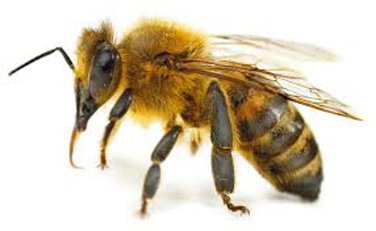
BEES
Bees are a very beneficial insect that must be protected here in Kansas City. We should not destroy the nest of bees or their hives. Bees produce honey which is a delicious food as well as pollinate many plants for humans to eat.
Flies
Flies and Fly control in Kansas City Missouri and Kansas
Revised by Richard M. Houseman
Division of Plant Sciences
More than 100,000 different kinds of flies have been discovered and named by scientists all over the world. Some common examples include house flies, horse flies, gnats, midges, and mosquitoes. All flies belong to the insect order Diptera, which means “two wings.” Since nearly all other insect groups have four wings, the name accurately reflects a unique feature of this group.
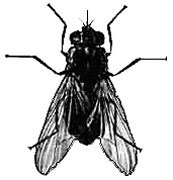
In nature, flies perform a vital function as decomposers of dead organisms, manure and decaying vegetation. These organic materials serve as breeding and egg-laying sites for the adult flies, and as food for immature flies, which are usually called maggots. Flies are also an important food source for many other kinds of organisms, including birds, fish, reptiles, and even some plants like the Venus flytrap.
Unfortunately, several species of flies and gnats have adapted to living in human structures. When flies are found in human structures, they are almost always considered to be nuisance pests. Some kinds of flies are also a potential threat to human or animal health. These flies may act as carriers of disease organisms present in their breeding and egg-laying sites. These disease organisms can cause food poisoning, diarrhea, dysentery or typhoid fever.
Household flies can be divided into two groups based on whether breeding and development normally occur indoors. Household infesting flies are those that breed and complete their life cycle indoors when breeding sites are available. Household invading flies are those that breed and develop outdoors but seek shelter indoors at certain times of the year. It is critical to identify which species of fly is occupying your home. Identification allows you to recognize conditions that are contributing to the infestation and pinpoint locations where fly management practices should be directed. We will briefly discuss some of the most common household flies in Kansas City.
House Fly (Musca domestica) Kansas City
House-infesting flies in Kansas City
Breeding and feeding habitats
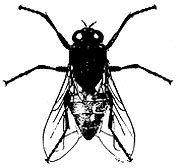
The house fly is the most common fly pest around homes. This fly lays eggs on wet, decaying organic matter such as moist garbage, animal manure or rotting plant debris. The eggs hatch into creamy white maggots that feed in the waste. Eventually, maggots change into an inactive pupal stage from which the adult flies later emerge. This life cycle is completed in about 14 days, depending on temperature.
Blow fly (Calliphoridae) Kansas City
House-infesting flies in Kansas City
Breeding and feeding habitats of flies in Kansas City
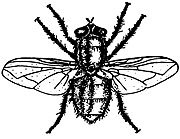
Several species of blow flies can be found infesting homes. These flies are shiny metallic colors of copper, green, blue or black. These flies lay their eggs on the carcasses of dead animals, decaying meat or garbage that contains meat scraps. The maggots hatch, grow to maturity by feeding on the meat, pupate, and then emerge as new adult flies. Development occurs over a 10 to 20 day period, depending on temperature.
Fruit fly (Drosophila spp.) Kansas City
House-infesting flies in Kansas City
Breeding and feeding habitats in Kansas City
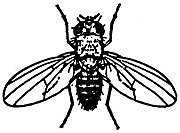
Fruit flies are also known as pomace flies or vinegar flies. Many of them are small (1/8 inch) and tan with red eyes. They are present outdoors during warm weather and may be pests inside during other times. They are more of an indoor nuisance during the fall when they enter houses to escape cooler outside temperatures. Fruit flies reproduce and develop on overripe and rotting fruits, vegetables, and other moist plant material. They are able to complete their life cycle in 10 to 12 days.
Phorid fly (Phoridae) Kansas City
House-infesting flies in Kansas City
Breeding and feeding habitats

Phorid flies are also called humpbacked flies. Adult flies are about 1/16 to 1/8 inch long, dark brown to almost black, and move in a characteristic short, nervous, jerky manner. The largest segment of the hind leg is distinctly flattened laterally. Phorid flies lay eggs on organic matter in moist conditions. The locations vary widely, but are usually associated with rotting fruit, vegetables or meat, wet organic soil, potted plants, cut flowers, garbage disposals and floor drains. Phorid flies often become pests in commercial kitchens, hospitals and mausoleums.
Moth fly (Psychodidae) Kansas City
House-infesting flies in Kansas City
Breeding and feeding habitats

Moth flies are also known as drain, filter or sewage flies. They are tiny flies and their bodies and wings are densely covered with hair. The wings are held rooflike above the body when at rest. Indoors, moth flies breed and the larvae develop in the wet, gelatinous material that lines the inside of drainpipes. They may also breed and develop in the filter beds of sewage treatment plants. The life cycle from egg to adult can take as little as 8 days or as long as 22 days, depending on temperature. In most situations, adult flies appear suddenly in the vicinity of sinks or drains. They are commonly noticed on the bathroom mirror. In unusual situations, large numbers of moth flies can develop in the filter beds of sewage treatment plants and be blown short distances to adjacent homes. In some cases, these flies are small enough to penetrate normal window screening.
Face fly (Musca autumnalis) Kansas City
House-infesting flies in Kansas City
Breeding and feeding habitats
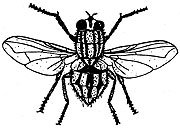
The face fly looks much like a house fly, but differs in its biology and habits. Face flies are pests of cattle in pastures during warm months and move into the walls of buildings during fall to pass the winter. During warm days in late winter and early spring, adults may be found indoors as they come out of hiding in the attic and walls. In these situations, adult flies usually appear in the windowsill on south-facing walls. Adult face flies lay their eggs exclusively on fresh cattle manure and the maggots feed on manure during their development. It takes 12 to 16 days to complete their life cycle.
Cluster fly (Pollenia rudis) Kansas City
House-infesting flies In Kansas City
Breeding and feeding habitats of flies in Kansas City
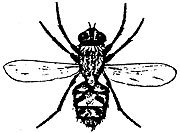
Cluster flies belong to the same family as blow flies but are not metallic in color. They are dark gray, with curved, golden yellow hairs on their back behind the head. Their movements are normally sluggish and when crushed, they give off the smell of honey. Cluster flies lay their eggs in the soil outdoors. After hatching, the maggots develop as parasites inside earthworms. Their life cycle typically requires 30 to 40 days. When adult flies emerge in late summer/early fall, they may enter human structures as to pass winter. In these cases, they are usually attracted to the top floors and attic on the south- and west-facing walls. On warm days during winter/spring cluster flies may become active and invade indoor living spaces.
Flesh fly (Sarcophagidae) Kansas City
House-invading flies in Kansas City
Breeding and feeding habitats of flies in Kansas City
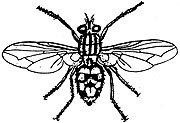
Flesh flies are gray with black stripes running along the top surface of the body just behind the head. They are usually the first insects to arrive at a dead animal carcass and are similar to blow flies in both larval and adult biology and habits. Flesh flies are attracted to sources of decay around the home, including garbage dumpsters, compost piles and dead animal carcasses. These odors bring them into close proximity to homes where they may invade through openings such as doors and windows or cracks and crevices. They usually do not infest homes but can be major pests of industrial buildings like meat processing facilities.
Stable fly (Stomoxys calcitrans) Kansas City
House-invading flies in Kansas City
Breeding and feeding habitats of flies in Kansas City
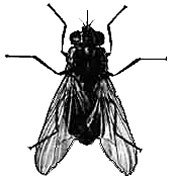
Stable flies are also called biting house flies. They resemble house flies but they have a needlelike piercing mouthpart folded below their head. Both sexes feed on the blood of warm-blooded animals, including humans, pets and livestock. They often bite through clothing, especially on the ankles. Peak biting times are in the early morning and late afternoon. Adults lay eggs in moist decaying vegetation such as compost piles, hay bales, straw animal bedding, decaying fruits and vegetables, and grass clippings. The larvae develop over a period of 15 to 20 days.
Fungus gnat (Mycetophilidae and Sciaridae) Kansas City
House-invading flies in Kansas City
Breeding and feeding habitats of flies in Kansas City
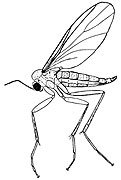
Fungus gnats are mosquito-like in appearance but are often much smaller. They are dark gray to almost black. The larvae develop in moist organic matter that contains fungi. Little is known about the details of their life cycle. Nearly all infestations indoors are attributed to highly organic, wet soil in potted plants or atriums. Rarely, poorly ventilated attics or accumulated bird feces can also serve as breeding sites. These flies may enter from outdoor breeding sites such as wet mulch near windows and doors. They are attracted to lights and will readily enter structures when doors or windows are left open — especially at night.
Management strategies for house-infesting flies in Kansas City
Sanitation for flies in Kansas City
Sanitation refers to activities that reduce or eliminate fly breeding and feeding habitats in and around the home. Important breeding sites for the flies mentioned in this publication are shown above. The proper management of garbage, yard and garden wastes, and dead animals reduces the availability of resources that are critical for the development of house flies, blow flies, fruit flies, flesh flies, and stable flies. Manure management reduces habitats for face flies. Cleaning drains minimizes the risk of moth flies and phorid flies, while reducing excess moisture will limit the number of potential breeding sites for gnats and phorid flies.
Household waste management is critical to sanitation. Use plastic garbage can liners inside trashcans that hold household waste. When plastic liners are full, close them tightly and transfer them directly to a large garbage can outdoors or in the garage. Make sure all garbage cans have tight-fitting lids and that they are cleaned whenever waste accumulates in the bottom or clings to the sides. Ensure that garbage is taken to the landfill or burned at the earliest possible opportunity.
Compost piles are an environmentally friendly way of recycling refuse. However, because they consist of decaying organic materials, they can serve as breeding sites for house flies, stable flies, fruit flies, blow flies and gnats. Neighbors may have legitimate complaints about nuisance flies coming from poorly maintained compost piles; however, well-managed compost piles normally generate significant amounts of heat during decay, which minimizes fly survival. If flies become a problem around your compost pile, one solution is to cover it with black plastic sheeting. The plastic serves as a barrier to flies, traps heat and reduces fly survival.
Other sanitary measures include spreading or burying animal manure and other wet waste. Removing, incinerating or burying dead animals is another important sanitary practice. It is also useful to remove overripe fruits and vegetables from the garden or incorporate them into the soil. If possible, reduce watering and organic matter in the soil of potted plants. Cleaning drains regularly or reducing moisture problems through ventilation and other means may be critical to eliminating some household fly infestations.
Management strategies for house-invading flies in Kansas City
Regardless of how well fly breeding sites are managed inside, flies will attempt to invade from outdoors.
Factors that influence fly invasions around homes include
Many kinds of fly invasions occur in response to seasonal environmental changes — especially when there is a stark contrast between outdoor and indoor temperatures.
Invading flies detect cool indoor air ‘leaking’ from buildings during hot periods and warm indoor air ‘leaking’ from buildings during cold periods. They enter the openings where they detect leaks. Common entry points include open doors and windows, gaps around door and window frames, cracks, and crevices. Barriers at these entry points are necessary to minimize fly invasions from outdoors.
Exterior lighting and odors will also attract flies to areas around human structures. Many flies are attracted to lights and will be found around exterior lighting at night. The smell of food odors from improperly maintained trashcans, compost bins or pet manure will also attract flies to areas around structures. After being attracted to the exterior of the home by lighting or odors, flies are able to gain access through open doors and windows, gaps, cracks or crevices.
Barriers for flies in Kansas City homes
Flies can squeeze through some amazingly small openings to enter buildings. Tight-fitting screening with 14 to 16 mesh (strands per inch) size are effective in excluding most flies. However, even the best screens may not keep out smaller species such as fruit flies, moth flies, phorid flies and fungus gnats. Screens should be installed on all openings, including doors, windows and vents.
Frequent inspection is required to ensure that screening is maintained in good condition.
In addition, as many cracks and crevices as possible on the exterior of the structure should be sealed with caulking or foam. Weatherstripping should be placed on the edges of doors and should be maintained in good condition. Kick plates below doors should also be in good repair.
Traps for flies in Kansas City
Resin strips (flypaper) may be hung in infested area if there is little or no air movement. Various designs have been produced. Some involve attractive odors or diagrams of flies in feeding or mating positions. A rule-of-thumb is one 10-inch strip per 1,000 cubic feet of space. Fly strips are effective for up to about three months (or until completely covered).
Insect light traps have been designed for capturing flies inside structures.
Light traps are some of the most effective methods for controlling flying insects inside structures. However, not all flies are attracted to light traps. This is another important reason to identify which type of fly has entered your home. Many flies show a mixed response to light traps because they fly during the day. However, flies that are active at night show a strong response to these traps. A variety of traps are available, but they must be used properly to be effective. See tips for using light traps for fly control.
Physical removal of flies in Kansas City
The fly swatter is an effective way to control a few individual flies that have occupied the living areas of your home. Vacuum cleaners can be effective for the removal of large numbers of dead flies in the attic or other area where flies have accumulated.
Removal of dead flies can be important because they can serve as a food source for other household invading insects.
Insecticides use for flies in Kansas City
Using insecticides should be considered as the last step in any fly management program. You should have already considered sanitation, barriers, traps and physical removal before deciding to use insecticides. In cases where insecticides are necessary, there are a variety of products to choose from, including baits, liquids, aerosols and dusts.
Ready-to-use baits can be used if they are placed outdoors in areas where flies congregate. Flies are attracted to the bait, feed on it, and die. The baits must be reapplied after rain or when the treated area has been cleaned with water. They should not be used where children or pets might come into contact with the bait.
A variety of over-the-counter products are sold for fly control in most hardware and nursery stores. These products contain pyrethrin or some kind of pyrethroid (allethrin, permethrin, resmethrin, sumithrin, deltamethrin or tetramethrin).
They generally provide quick knockdown of flies and have a short-term effect. You must read and follow the label directions. It is illegal to use these products in a way that violates the instructions on the label.
Spot treatments with long-lasting sprays are useful for killing flies outside the home. These compounds are only available to licensed pest management professionals. These sprays are applied to areas where flies rest, such as outer walls (especially the south- and west-facing), under porches, and in garages, breezeways and doghouses. Liquids can also be applied with a brush around windowsills outdoors.
Outdoor treatments are especially useful if applied just before cluster flies and face flies begin to seek places to pass the winter. Ensure that pets are removed from areas that are being treated and do not allow them to return until the insecticide is dry. Contact a variety of companies before deciding which one to hire.
Tips for using light traps to control household flies in Kansas City
Warning
Apply chemicals only where needed or justified. Before using any chemical, please read the label carefully for directions on application procedures, appropriate rate, first aid, storage, and disposal. Make sure that the chemical is properly registered for use on the intended pest and follow all other label directions.
Keep insecticides in original containers, complete with labels, and keep them out of the reach of children and pets. Do not allow children or pets near treated areas before these areas dry. Carefully and properly dispose of unused portions of diluted sprays and empty insecticide containers.
Written by Darryl Sanders, Department of Entomology
G7388, reviewed May 2010
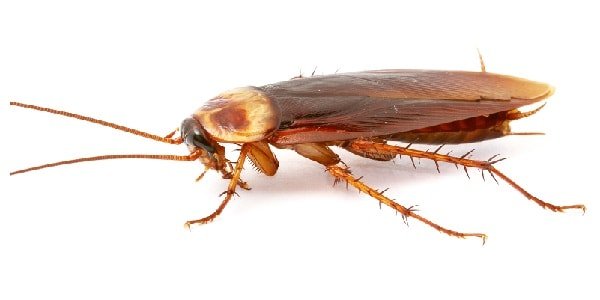
COCKROACHES
The German cockroach in Kansas City
Blattella germanica [Blattodea: Blattellidae]: The German cockroach in Kansas City is native to southeastern Asia. It has been widely spread to all parts of the world. Breeding populations can become established almost anywhere, where conditions for comfortable human existence prevail. Infestations of cockroaches have been detected in all parts of the world, including Alaska and Greenland. Some will confuse Cockroaches with Crickets in Kansas City.
The adult German male and cockroach female are fully winged and measure 1.1-1.6 cm in length. Adult German cockroaches are incapable of actual flight. The female German cockroach in Kansas City carries the partially extruded ootheca until the eggs hatch. During this time, the female roach remains inside harborages and feed little if at all.
Cockroaches in Kansas City are a common occurrence. Developmental time for a German cockroach is from two to six months, depending on temperature and humidity. The German cockroach breeds continuously in Kansas City, and the German cockroach populations can reach large numbers in a short amount of time. We are an exterminator in Kansas City that can take care of your pest control needs in Kansas City.
MOSQUITO
Mosquitoes are a pest no one wants around. Mosquitoes can transmit encephalitis like the West Nile Virus. The best way to keep mosquito populations down would be to go to the breeding source. Any standing, stagnating water around your home must be eliminated, as well as old tires, plant pots with water basins, and birdbaths. Mosquitoes breed in water, and it is necessary for their survival.
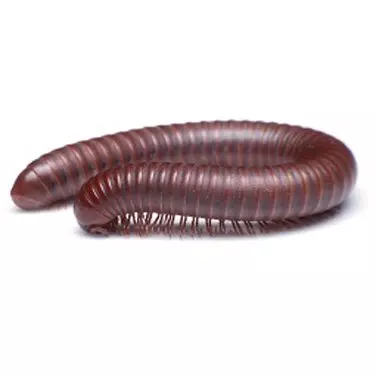
MILLIPEDE
Millipede in Kansas City is an occasional invader that is a pest primarily due to organic matter around your home or high levels of moisture. Leaf litter around your home or stored items around your house that cause moisture to build up.
Bed Bugs
FAQ about bed bugs in Kansas City
There is a real problem with bed bug infestations in the U.S., especially here in Kansas City. As a company, we went from 1-2 calls a year in 2005 for bed bugs to 1-2 per week in 2009 to 5-15 calls a day in 2014.
Cost is based on many factors, whether you have a heat treatment done or a treatment using products like liquids and dusts, the number of rooms being heated or treated with products, and the size of the unit being treated.
It is not possible to bring your home up to 125 degrees and maintain that temperature for an extended time for you to kill all stages of bed bugs from egg to nymphs to adults. Your furnace will shut off around 90 degrees which will not be hot enough.
Alcohol will kill the bugs you see and treat directly, but will not kill the eggs and the bugs you don't see.
A whole house heat treatment can take between 8 to 12 hours.
You will not want to be in the house as it will be between 125-135 degrees for an extended amount of time.
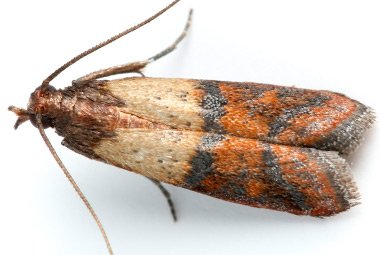
MOTH
Indian meal moths in Kansas City are a pantry pest and can be controlled by finding the source that is infested in your cabinets. IMM can infest all kinds of grains, dog food, birdseed, pasta, oats, nuts, and just about anything you store long term in your pantry or garage. The best pest control solution to get rid of them is to throw away what is infested.
RODENT
We have several mice species in Kansas City. We also have Norway rats that will invade your Kansas City home. At least 90% of the time, rats and mice will enter through the garage. Rodent proofing your garage is a very important step in keeping rodents out of your home. Going around the outside of your home and finding all the holes that come into your home and fixing them will also help with rodent problems.
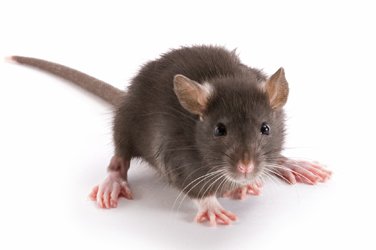
ZIPZAP TERMITE & PEST CONTROL
If you find a bug in or around your home and need it identified, take a picture. Then text or email to the text line or email address below.
Please DO NOT text to the (816) 407-PEST number.
